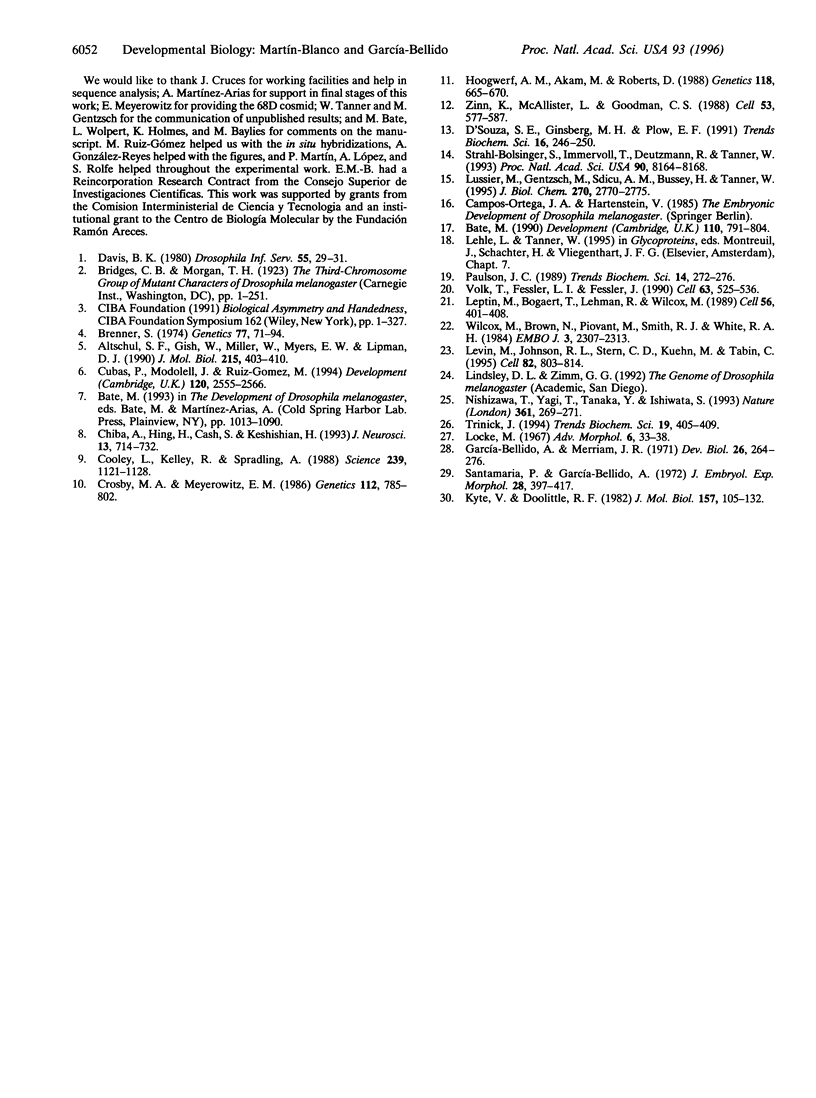Abstract
In bilateral animals, the left and right sides of the body usually present asymmetric structures, the genetic bases of whose generation are still largely unknown [CIBA Foundation (1991) Biological Asymmetry and Handedness, CIBA Foundation Symposium 162 (Wiley, New York), pp. 1-327]. In Drosophila melanogaster, mutations in the rotated abdomen (rt) locus cause a clockwise helical rotation of the body. Even null alleles are viable but exhibit defects in embryonic muscle development, rotation of the whole larval body, and helical staggering of cuticular patterns in abdominal segments of the adult. rotated abdomen is expressed in the embryonic mesoderm and midgut but not in the ectoderm; it encodes a putative integral membrane glycoprotein (homologous to key yeast mannosyltransferases). Mesodermal cells defective in O-glycosylation lead to an impaired larval muscular system. We propose that the staggering of the adult abdominal segments would be a consequence of the relaxation of intrinsic rotational torque of muscle architecture, preventing the colateral alignment of the segmental histoblast cells during their proliferation at metamorphosis.
Full text
PDF




Images in this article
Selected References
These references are in PubMed. This may not be the complete list of references from this article.
- Altschul S. F., Gish W., Miller W., Myers E. W., Lipman D. J. Basic local alignment search tool. J Mol Biol. 1990 Oct 5;215(3):403–410. doi: 10.1016/S0022-2836(05)80360-2. [DOI] [PubMed] [Google Scholar]
- Bate M. The embryonic development of larval muscles in Drosophila. Development. 1990 Nov;110(3):791–804. doi: 10.1242/dev.110.3.791. [DOI] [PubMed] [Google Scholar]
- Brenner S. The genetics of Caenorhabditis elegans. Genetics. 1974 May;77(1):71–94. doi: 10.1093/genetics/77.1.71. [DOI] [PMC free article] [PubMed] [Google Scholar]
- Chiba A., Hing H., Cash S., Keshishian H. Growth cone choices of Drosophila motoneurons in response to muscle fiber mismatch. J Neurosci. 1993 Feb;13(2):714–732. doi: 10.1523/JNEUROSCI.13-02-00714.1993. [DOI] [PMC free article] [PubMed] [Google Scholar]
- Cooley L., Kelley R., Spradling A. Insertional mutagenesis of the Drosophila genome with single P elements. Science. 1988 Mar 4;239(4844):1121–1128. doi: 10.1126/science.2830671. [DOI] [PubMed] [Google Scholar]
- Crosby M. A., Meyerowitz E. M. Lethal mutations flanking the 68C glue gene cluster on chromosome 3 of Drosophila melanogaster. Genetics. 1986 Apr;112(4):785–802. doi: 10.1093/genetics/112.4.785. [DOI] [PMC free article] [PubMed] [Google Scholar]
- Cubas P., Modolell J., Ruiz-Gómez M. The helix-loop-helix extramacrochaetae protein is required for proper specification of many cell types in the Drosophila embryo. Development. 1994 Sep;120(9):2555–2566. doi: 10.1242/dev.120.9.2555. [DOI] [PubMed] [Google Scholar]
- D'Souza S. E., Ginsberg M. H., Plow E. F. Arginyl-glycyl-aspartic acid (RGD): a cell adhesion motif. Trends Biochem Sci. 1991 Jul;16(7):246–250. doi: 10.1016/0968-0004(91)90096-e. [DOI] [PubMed] [Google Scholar]
- Garcia-Bellido A., Merriam J. R. Clonal parameters of tergite development in Drosophila. Dev Biol. 1971 Oct;26(2):264–276. doi: 10.1016/0012-1606(71)90126-6. [DOI] [PubMed] [Google Scholar]
- Hoogwerf A. M., Akam M., Roberts D. A genetic analysis of the rose-gespleten region (68C8-69B5) of Drosophila melanogaster. Genetics. 1988 Apr;118(4):665–670. doi: 10.1093/genetics/118.4.665. [DOI] [PMC free article] [PubMed] [Google Scholar]
- Kyte J., Doolittle R. F. A simple method for displaying the hydropathic character of a protein. J Mol Biol. 1982 May 5;157(1):105–132. doi: 10.1016/0022-2836(82)90515-0. [DOI] [PubMed] [Google Scholar]
- Leptin M., Bogaert T., Lehmann R., Wilcox M. The function of PS integrins during Drosophila embryogenesis. Cell. 1989 Feb 10;56(3):401–408. doi: 10.1016/0092-8674(89)90243-2. [DOI] [PubMed] [Google Scholar]
- Levin M., Johnson R. L., Stern C. D., Kuehn M., Tabin C. A molecular pathway determining left-right asymmetry in chick embryogenesis. Cell. 1995 Sep 8;82(5):803–814. doi: 10.1016/0092-8674(95)90477-8. [DOI] [PubMed] [Google Scholar]
- Locke M. The development of patterns in the integument of insects. Adv Morphog. 1967;6:33–88. doi: 10.1016/b978-1-4831-9953-5.50006-8. [DOI] [PubMed] [Google Scholar]
- Lussier M., Gentzsch M., Sdicu A. M., Bussey H., Tanner W. Protein O-glycosylation in yeast. The PMT2 gene specifies a second protein O-mannosyltransferase that functions in addition to the PMT1-encoded activity. J Biol Chem. 1995 Feb 10;270(6):2770–2775. doi: 10.1074/jbc.270.6.2770. [DOI] [PubMed] [Google Scholar]
- Nishizaka T., Yagi T., Tanaka Y., Ishiwata S. Right-handed rotation of an actin filament in an in vitro motile system. Nature. 1993 Jan 21;361(6409):269–271. doi: 10.1038/361269a0. [DOI] [PubMed] [Google Scholar]
- Paulson J. C. Glycoproteins: what are the sugar chains for? Trends Biochem Sci. 1989 Jul;14(7):272–276. doi: 10.1016/0968-0004(89)90062-5. [DOI] [PubMed] [Google Scholar]
- Santamaria P., García-Bellido A. Localization and growth pattern of the tergite Anlage of Drosophila. J Embryol Exp Morphol. 1972 Oct;28(2):397–417. [PubMed] [Google Scholar]
- Strahl-Bolsinger S., Immervoll T., Deutzmann R., Tanner W. PMT1, the gene for a key enzyme of protein O-glycosylation in Saccharomyces cerevisiae. Proc Natl Acad Sci U S A. 1993 Sep 1;90(17):8164–8168. doi: 10.1073/pnas.90.17.8164. [DOI] [PMC free article] [PubMed] [Google Scholar]
- Trinick J. Titin and nebulin: protein rulers in muscle? Trends Biochem Sci. 1994 Oct;19(10):405–409. doi: 10.1016/0968-0004(94)90088-4. [DOI] [PubMed] [Google Scholar]
- Volk T., Fessler L. I., Fessler J. H. A role for integrin in the formation of sarcomeric cytoarchitecture. Cell. 1990 Nov 2;63(3):525–536. doi: 10.1016/0092-8674(90)90449-o. [DOI] [PubMed] [Google Scholar]
- Wilcox M., Brown N., Piovant M., Smith R. J., White R. A. The Drosophila position-specific antigens are a family of cell surface glycoprotein complexes. EMBO J. 1984 Oct;3(10):2307–2313. doi: 10.1002/j.1460-2075.1984.tb02131.x. [DOI] [PMC free article] [PubMed] [Google Scholar]
- Zinn K., McAllister L., Goodman C. S. Sequence analysis and neuronal expression of fasciclin I in grasshopper and Drosophila. Cell. 1988 May 20;53(4):577–587. doi: 10.1016/0092-8674(88)90574-0. [DOI] [PubMed] [Google Scholar]





